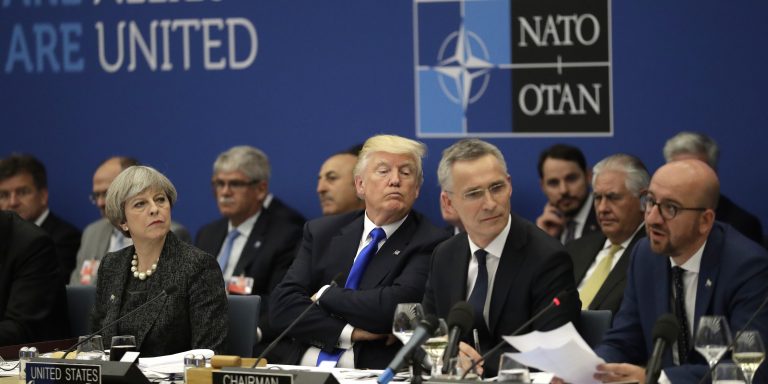INTELBRIEF
June 28, 2018
IntelBrief: The U.S. and NATO: From Partners to Competitors

- On July 11, U.S. President Trump will attend the NATO summit in Brussels at a time of unprecedented tensions within the group.
- Beyond President Trump’s open disdain for NATO are his rhetoric and actions over tariffs, making cooperation with allies on security matters difficult.
- NATO leaders doubt President Trump’s basic commitment to the goals of the Alliance.
- While in Europe, President Trump is expected to meet with Russian President Vladimir Putin, an increasing source of concern for NATO.
.
The open hostility President Trump showed to the leaders of long-time allies during the May meeting of the G7 in Canada was unprecedented. Following that, the heads of NATO are now bracing for their July 11-12 meeting in Brussels. The NATO alliance is among the most successful military alliances in modern times and provides benefits to the U.S. that far outweigh its costs.
It is those costs that appear to be President Trump’s source of contention with NATO. However, he has repeatedly misstated how it is supported, claiming there is a general fund into which all NATO members pay. The reality is that each of the 29 member nations determines their own military needs and pays for their own military defense. The targeted goal is 2% of total GDP spent on defense, with an additional goal that 20% of military spending goes towards equipment. NATO is a collective force, not a stand-alone force. The number of members that will meet the 2% goal by 2024 is now 18, and, as noted in a June 26, 2018, New York Times article, ‘the level of non-American allied military spending has gone up some $87 billion since 2014 and continues to grow.’
The tensions between the U.S. and other NATO members goes far beyond finances, however, to the heart of the transatlantic partnership. President Trump views all alliances as transactional and believes most other countries—especially western European countries—are taking advantage of the U.S. Trump also thinks NATO and the EU benefit unfairly from the stability and security provided by, and at great cost to, the U.S. The G7 debacle has cemented European fears about the path that President Trump is following in further degrading the U.S.’ traditional alliances.
Trump’s views on immigration, a free press, and humanitarian aid are in opposition to many of the views of European leaders. In an unprecedented move, President Trump tweeted that German Chancellor Merkel was in political trouble because of her stances onimmigration. He tweeted: ‘The people of Germany are turning against their leadership as migration is rocking the already tenuous Berlin coalition. Crime in Germany is way up. Big mistake made all over Europe in allowing millions of people in who have so strongly and violently changed their culture!’ Besides the odd decision to publicly ridicule the leader of a close ally, the President was factually incorrect about Germany’s crime rate, which is at a 25-year low.
Fellow NATO members are worried that the U.S. is moving away from the security pact—both philosophically and literally. It is no longer fanatical speculation to question the U.S.’ full commitment to NATO—a position that would have been unthinkable not long ago. Even more troubling is the disconnect between the U.S President, who not only mocks NATO but in some cases is openly supportive of Russia’s President Putin, and Defense Secretary James Mattis, who is working to strengthen NATO’s capabilities specifically against Russian aggression.
.
For tailored research and analysis, please contact: info@thesoufancenter.org
[video width="960" height="540" mp4="https://thesoufancenter.org/wp-content/uploads/2018/06/IB-0628.mp4" poster="https://thesoufancenter.org/wp-content/uploads/2018/06/AP_17145639388010.jpg"][/video]